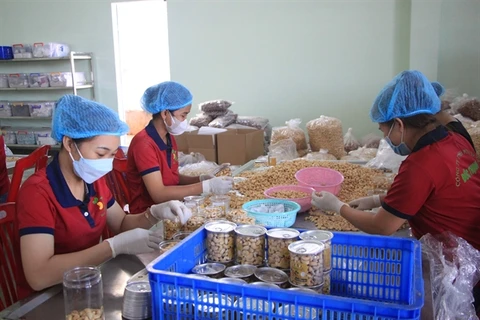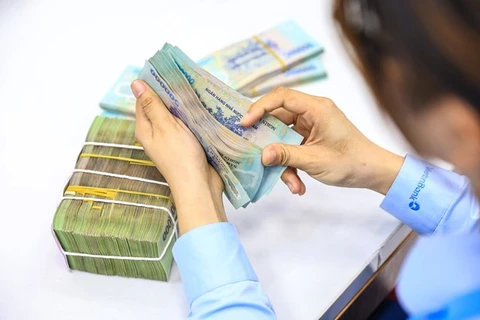Hanoi (VNS/VNA) - Firms can borrow from the Small- and Medium-sized Enterprise (SME) Development Fund with a short-term interest rate of 1.2% per year and a long-term interest rate of 4.4% per year, effective from October 4, 2023, the Ministry of Planning and Investment announced.
According to the fund’s representatives, the preferential interest rates are applied in accordance with Resolution No 105/NQ-CP dated July 15, 2023, of the Government on tasks and solutions to remove difficulties for production and business.
Besides the fund, many banks have also continued to provide loans for firms with low interest rates.
For example, from now until May 30, 2024, corporate customers borrowing capital for production and business at SHB will enjoy preferential loan interest rates from only 6.97% per year. Accordingly, SHB will set aside 5 trillion VND with interest rates from 6.97% to support firms in supplementing short-term working capital. Enterprises that enjoy the SHB’s incentives include female-owned enterprises and enterprises operating in priority fields such as agriculture, forestry, fisheries, exports, high technology, transport infrastructure, education, healthcare and green projects.
At the same time, SHB will also spend 1 trillion VND for corporate customers who need loans for car purchases with loan terms of 36 months or more. Based on needs and capital usage plans, customers can choose preferential interest rates from 7.5% per year for the first six months or from 9% per year for 12 months.
According to the State Bank of Vietnam, deposit interest rates in the last quarter of a year in previous years often increased to attract idle capital to banks to serve the rising lending needs of people and firms for year-end, but this year is different as deposit interest rates at most banks are anchored at low levels and some even continue to decrease.
Specifically, deposit interest rates at some banks such as VPBank, ACB and Bac A Bank have continued to decrease by 0.15 - 0.3 percentage points for many terms since early this month.
The highest deposit interest rate at VPBank is only 5.5% per year for 12-month and 13-month terms, instead of the previous rate of 5.8% per year. Tenors from 6-9 months also decrease from 5.3% per year to 5.1% per year.
At ACB, the interest rate for deposits under 200 million VND, with a term of 6-9 months, decreases from 5-2-5.3% per year to 5-5.1% per year. For deposits from 200 million VND to less than 1 billion VND, the rate is added 0.1% per year while for deposits of 1 billion VND or more, the rate is added 0.05% per year./.
According to the fund’s representatives, the preferential interest rates are applied in accordance with Resolution No 105/NQ-CP dated July 15, 2023, of the Government on tasks and solutions to remove difficulties for production and business.
Besides the fund, many banks have also continued to provide loans for firms with low interest rates.
For example, from now until May 30, 2024, corporate customers borrowing capital for production and business at SHB will enjoy preferential loan interest rates from only 6.97% per year. Accordingly, SHB will set aside 5 trillion VND with interest rates from 6.97% to support firms in supplementing short-term working capital. Enterprises that enjoy the SHB’s incentives include female-owned enterprises and enterprises operating in priority fields such as agriculture, forestry, fisheries, exports, high technology, transport infrastructure, education, healthcare and green projects.
At the same time, SHB will also spend 1 trillion VND for corporate customers who need loans for car purchases with loan terms of 36 months or more. Based on needs and capital usage plans, customers can choose preferential interest rates from 7.5% per year for the first six months or from 9% per year for 12 months.
According to the State Bank of Vietnam, deposit interest rates in the last quarter of a year in previous years often increased to attract idle capital to banks to serve the rising lending needs of people and firms for year-end, but this year is different as deposit interest rates at most banks are anchored at low levels and some even continue to decrease.
Specifically, deposit interest rates at some banks such as VPBank, ACB and Bac A Bank have continued to decrease by 0.15 - 0.3 percentage points for many terms since early this month.
The highest deposit interest rate at VPBank is only 5.5% per year for 12-month and 13-month terms, instead of the previous rate of 5.8% per year. Tenors from 6-9 months also decrease from 5.3% per year to 5.1% per year.
At ACB, the interest rate for deposits under 200 million VND, with a term of 6-9 months, decreases from 5-2-5.3% per year to 5-5.1% per year. For deposits from 200 million VND to less than 1 billion VND, the rate is added 0.1% per year while for deposits of 1 billion VND or more, the rate is added 0.05% per year./.
VNA
























